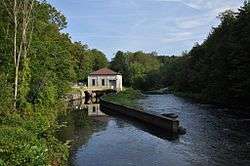Glendale Power House
The Glendale Power House is a historic power station on the Housatonic River, just off Massachusetts Route 183 in Stockbridge, Massachusetts. The 1905 power house, built for the Monument Mills, was the one of the first places in the United States where electricity was generated for the purpose of providing power to an industrial facility. The station was listed on the National Register of Historic Places in 1982.[1] The facility has been rehabilitated and converted into modernized hydroelectric power generation plant.
Glendale Power House | |
 | |
  | |
| Location | Housatonic River off MA 183, Stockbridge, Massachusetts |
|---|---|
| Coordinates | 42°16′50″N 73°21′11″W |
| Area | 13.3 acres (5.4 ha) |
| Built | 1905 |
| Architect | F.O. Toquet |
| NRHP reference No. | 82004957[1] |
| Added to NRHP | June 24, 1982 |
Description and history
The Glendale Power House is located southwest of Stockbridge's village center, sandwiched between Massachusetts Route 183 on the northwest bank of the Housatonic River, below the point where Glendale Middle Road crosses the river. The property is over 13 acres (5.3 ha) in size, with a dam at the northern end (just south of the bridge), a power canal 1,500 feet (460 m) in length, and a stone power house. The dam is 28 feet (8.5 m) in height, and is built out of poured concrete. The canal is 40 feet (12 m) wide, and was dug out of heavy clay. The power house is a single-story stone structure, three bays wide and four long, with a slate roof. The interior is a single large chamber, which historically house turbines and electrical control equipment. A sliding gantry-style crane provided the means to move equipment around within the building for maintenance.[2]
The power plant was built in 1905 by Monument Mills of Housatonic, at the site of a dam that dated to the 1840s for a papermaking operation. The stone building uses stone originally quarried for the Glendale Woolen Mill. By 1909, this plant was providing half of the mills' power requirements. The power station was taken out of service in 1946, and most of its original generation equipment removed.[3] The property was redeveloped to provide hydroelectrict power to the main grid in the 1980s.[3] Its four turbines can produce 1.07 MW of electricity.[4] Electricity generation depends on the availability of water; during a drought, the water level might fall too low to run the turbines.
References
- "National Register Information System". National Register of Historic Places. National Park Service. April 15, 2008.
- "NRHP nomination for Glendale Power House". National Archives. Retrieved 2017-12-30.
- "MACRIS inventory record for Glendale Power House". Commonwealth of Massachusetts. Retrieved 2013-12-02.
- Enel Green Power North America website, http://www.enelgreenpower.com/en-GB/ena/power_plants/ne/glendale/ Archived 2014-10-06 at the Wayback Machine accessed 2014-10-03.
